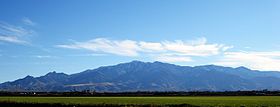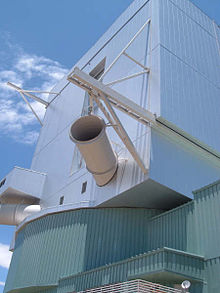- Mount Graham
-
Mount Graham
Mount Graham, SaffordElevation 10,720 ft (3,267 m) Prominence 6,320 ft (1,926 m) Listing List of mountains in Arizona Location Location Graham County, Arizona, USA Range Pinaleño Mountains Coordinates 32°42′05.87″N 109°52′18.87″W / 32.7016306°N 109.8719083°WCoordinates: 32°42′05.87″N 109°52′18.87″W / 32.7016306°N 109.8719083°W Topo map USGS Mount Graham Mount Graham is a mountain in southeastern Arizona in the United States, in the Coronado National Forest. It is the highest mountain in the Pinaleño Mountains. As the name "Mount Graham" is often used by locals to refer to the entire mountain range, the peak itself is frequently referred to as "High Peak".[1] The mountain reaches 10,720 feet (3,267 m) in height, attaining the highest elevation in Graham County. It is twentieth of the 57 ultra prominent peaks of the lower 48 states, and the first of the five in Arizona.
Mount Graham summits are headwaters for numerous perennial streams that tumble through five major botanical zones. Located between the southern Rocky Mountains and Mexico’s Sierra Madre Occidental, and biologically isolated for millennia, the higher elevations have provided refuge for relict populations of plants and animals with adaptive strategies rooted in Pleistocene ice age environmental conditions. Of particular note are stands of the oldest conifer trees in the U.S. Southwest and associated habitats for threatened and endangered species, especially the Mount Graham Red Squirrel.[2]
Located near the northern limit of the Chiricahua Apache homeland and the southern margins of Western Apache territory, the range is one of the Western Apache’s four holiest mountains and is considered sacred by all of the region's Native peoples. Since a determination by the Keeper of the Register in 2002, Dził Nchaa Si An, as it is known in the Western Apache language, ranks as the largest and most extensive (~330,000 acres) property listed on or formally determined eligible for the National Register of Historic Places.[3]
In 1993, the St. Paisius Orthodox Monastery was founded at the base of the mountain.
In 2009, Mt. Graham became the only place on Earth with five species of trout living on the mountain.[4]
Contents
Mount Graham Observatory
Mount Graham, with some of the clearest skies in the world, is home to the Mount Graham International Observatory area, where multiple organizations have set up large telescopes in a few separate observatories authorized by a rare peace-time Congressional waiver of U.S. environmental laws.[5]
The United States Congress authorized construction of observatories on the mountain in 1988, but there has been outcry from the four federally recognized tribes of the Western Apache Nation and Native American groups, who consider the site to be sacred. Environmental groups, including the Sierra Club also oppose the Mount Graham International Observatory because the higher elevations are the last remaining habitat for the Mount Graham Red Squirrel.
See also
- Heinrich Hertz Submillimeter Telescope
- Large Binocular Telescope
- Mountain peaks of North America
- Mountain peaks of the United States
- Vatican Advanced Technology Telescope
References
- ^ http://ag.arizona.edu/research/redsquirrel/pinaleno.html Pinaleños Mountains
- ^ T. W. Swetnam and P.M. Brown “Oldest known conifers in the Southwestern United States: Temporal and Spatial patterns of Maximum Age,” In M.R. Kaufmann, W.H. Moir, and R.L. Bassett, eds., Old-Growth Forests in the Southwest and Rocky Mountain Regions, Proceedings of a Workshop. USDA Forest Service General Technical Report RM 213: 24-38 (1992); Henry D. Grissino-Mayer and Harold C. Fritts, “Dendroclimatology and Dendroecology in the Pinaleño Mountains, In Conrad A. Istock and Robert S. Hoffmann, eds., Storm over a Mountain Island: Conservation Biology and the Mt. Graham Affair, pp. 100-120 (Tucson: University of Arizona Press, 1995).
- ^ Elizabeth A. Brandt, “The Fight for Dził Nchaa Si'an, Mt. Graham: Apaches and Astrophysical Development in Arizona,” Cultural Survival Quarterly (Winter) 1996: 50-57; John R. Welch, “White Eyes' Lies and the Battle for Dził Nchaa Si'an,” American Indian Quarterly 21 1997:75-109; Patricia M. Spoerl, Determination of Eligibility for the National Register of Historic Places, Mt. Graham (Dzil nchaa si’an) Safford Ranger District, Coronado National Forest, Arizona. Prepared under an agreement with the University of Arizona and submitted to the Keeper of the National Register by Coronado National Forest (2001); Mary M. Farrell, “Proposed MGIO Permit Renewal Determination of Effect,” Heritage Resources Report 2008-05-076 (Tucson: Coronado National Forest, April 7, 2008).
- ^ http://eacourier.com/articles/2009/11/29/news/update/doc4afa0c84075bf954254182.txt From video
- ^ "100th Congress": "Public law 100-696" Retrieved on 2009-04-16
External links
- U.S. Geological Survey Geographic Names Information System: Mount Graham
- PeakBagger.com: Mount Graham
- summitpost.org: Mount Graham
- Mount Graham International Observatory home page
- Mount Graham International Observatory another site
- Mt. Graham Coalition an opposition group
- St. Paisius Orthodox Monastery
 State of Arizona
State of ArizonaPhoenix (capital) Topics Index | Climate | Delegations | Geography | History | Museums | Music | People | Transportation | Visitor Attractions
Society Culture · Demographics · Economy · Education · Politics
Regions Arizona Strip | Arizona Sun Corridor | Coconino Plateau | Colorado Plateau | Grand Canyon | Kaibab Plateau | Mogollon Plateau | Mogollon Rim | Mojave Desert | Monument Valley | North Central Arizona | Northeast Arizona | Northern Arizona | Oak Creek Canyon | Phoenix Metropolitan Area | Safford area | San Francisco Volcanic Field | Sonoran Desert | Southern Arizona | Verde Valley | White Mountains
Counties Cities Chandler | Flagstaff | Gilbert | Glendale | Kingman | Lake Havasu City | Mesa | Peoria | Phoenix | Prescott | Scottsdale | Sierra Vista | Tempe | Tucson | Yuma
Categories:- Mountains of Arizona
- Landforms of Graham County, Arizona
Wikimedia Foundation. 2010.


